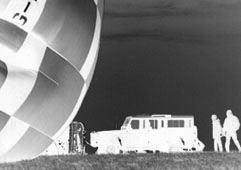You won't get far without film but which one do you choose. Ask for a film in any photo shop and you will be faced with a choice from dozens of films from a load of different manufacturers. To help you make an educated choice we will look at some of the terms that may be helpful to understand and some of the factors you will have to consider when selecting a particular film for a particular purpose.
Film comes in a variety of shapes and sizes but for the purposes of these tutorials we will look at the most popular amateur formats of 35mm and APS although it is all the same stuff just cut up differently; apart from APS which is a little different and only comes in one size anyway.
- 35 mm or APS. (Advanced Photo System)
- Negative or Positive. (Print or Slide.)
- Colour or Black and White.
- Film Speed. (more here.)
35 mm (135) film goes in 35 mm camera and APS film goes in an APS camera. Make sure you buy the right one. There are two main differences between 35 mm and APS:
1 APS is slightly smaller than 35 mm.
2 APS film has an extra layer which allows it to record information from the camera to be passed on to the processing equipment.
The actual emulsion, the light sensitive coating that makes film work, is basically the same in both formats.
 Negative. (Print)
Negative. (Print)
If your intention is to end up with a nice set of photographic prints then you want to use a negative film. Quite often says 'film for colour prints' on the box if you are using colour film. Your exposed film will have to be processed to create a 'negative' which has the tones , the light and dark bits, and colours reversed. The negative is then used to produce a print or 'positive'. This is done using an enlarger to project the negative image onto light sensitive printing paper. The paper is then processed to reveal the positive image.

Positive. (Slide/Reversal)
Positive film, as you would expect, is the opposite of negative film. After processing the film you will have a set of positive images. You will usually get them returned to you in individual plastic frames as mounted slides. Many people call them 'slides' but they are more correctly referred to as 'transparencies'. To properly view slides or transparencies you should project them onto a white screen in a darkened room or use a purpose made slide viewer.

This is down to personal choice. There are a huge variety of films available in colour negative, colour slide and black and white negative. If you would like to produce Black and White transparencies you are limited to a choice, at least currently, of Agfa Scala or processing negative film in a reversal process.
The previous choices have been fairly straight forward but choice of film speed may require a little more thought. Slow films will have finer grain than fast film however slow films by their very nature may involve using shutter speeds which are to slow for the intended purpose. Faster films on the other hand may allow you to use fast enough shutter speeds to hand hold the camera or freeze fast movement. The downside of this apparent convenience is an increase in grain.
General purpose films in the 100 ASA to 200 ASA range are relatively fine grained and sensitive enough to use under a wide variety of lighting conditions.
If you feel you really need fine grain then you will have to accept the resulting slow shutter speeds and get yourself a decent tripod.
If you really want those fast shutter speeds you will have to accept the increase in grain that comes with the extra speed.
These are the steps you may take in choosing a film but there are a few more terms that you should may want to understand before using your film.
